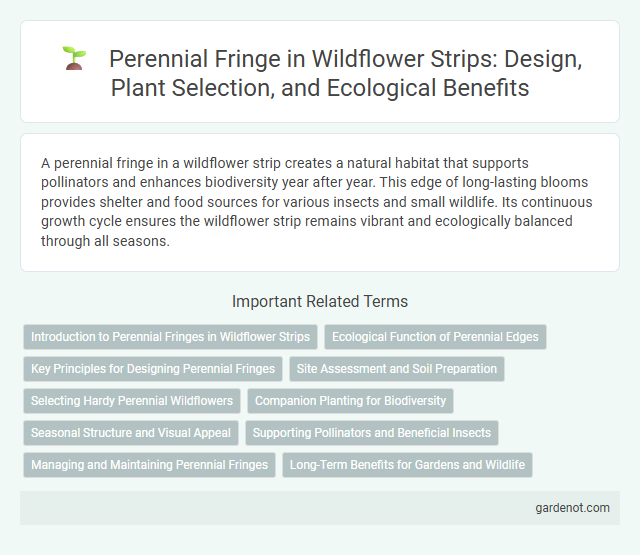A perennial fringe in a wildflower strip creates a natural habitat that supports pollinators and enhances biodiversity year after year. This edge of long-lasting blooms provides shelter and food sources for various insects and small wildlife. Its continuous growth cycle ensures the wildflower strip remains vibrant and ecologically balanced through all seasons.
Introduction to Perennial Fringes in Wildflower Strips
Perennial fringes in wildflower strips consist of long-lasting herbaceous plants that provide consistent habitat and nourishment for pollinators throughout multiple growing seasons. These fringes enhance biodiversity by supporting native insects, birds, and soil health while stabilizing the strip's edges against erosion. Integrating diverse perennial species strengthens ecosystem resilience and promotes sustainable pest management within agricultural landscapes.
Ecological Function of Perennial Edges
Perennial fringes in wildflower strips provide crucial ecological functions by enhancing biodiversity and supporting pollinator habitats. These edge habitats stabilize soil, reduce erosion, and facilitate nutrient cycling, contributing to ecosystem resilience. Their continuous floral resources ensure food availability for pollinators throughout multiple seasons, promoting sustainable wildlife populations.
Key Principles for Designing Perennial Fringes
Perennial fringe design emphasizes selecting native, drought-tolerant species that enhance soil stability and provide habitat diversity. Incorporating layered planting with varying heights and bloom times maximizes ecological benefits and visual appeal. Effective drainage management and maintenance planning ensure long-term sustainability of the perennial fringe ecosystem.
Site Assessment and Soil Preparation
Site assessment for perennial fringe in wildflower strips requires detailed evaluation of soil type, drainage capacity, and existing vegetation to ensure optimal plant establishment. Soil preparation involves deep tillage to improve soil structure, incorporation of organic matter to enhance fertility, and adjustment of pH levels tailored to native wildflower species requirements. Properly prepared soil promotes root development, moisture retention, and nutrient availability essential for perennial fringe longevity.
Selecting Hardy Perennial Wildflowers
Selecting hardy perennial wildflowers for a wildflower strip ensures long-lasting blooms that withstand varying weather conditions and soil types. Species such as Echinacea purpurea, Rudbeckia fulgida, and Coreopsis lanceolata offer robust growth and vibrant colors, attracting pollinators year after year. Emphasizing native plants enhances ecosystem resilience and supports local biodiversity in the perennial fringe.
Companion Planting for Biodiversity
Perennial fringe plants create a dynamic edge in wildflower strips, enhancing companion planting strategies that boost biodiversity by attracting pollinators and beneficial insects. Integrating species such as Echinacea, Rudbeckia, and Monarda supports diverse wildlife habitats and improves ecosystem resilience. These companion perennials promote soil health, pest control, and floral variety, essential for sustainable wildflower strip management.
Seasonal Structure and Visual Appeal
A perennial fringe in a wildflower strip offers dynamic seasonal structure by showcasing successive blooms from spring through fall, enhancing biodiversity and providing continuous habitat for pollinators. The varied heights and textures create an eye-catching visual appeal that shifts with the seasons, adding depth and interest to garden borders or naturalized areas. Selecting species with staggered flowering times ensures lasting color and ecological benefits throughout the growing season.
Supporting Pollinators and Beneficial Insects
Perennial fringe plants in a wildflower strip provide essential nectar and pollen resources that support diverse pollinators such as bees, butterflies, and hoverflies. These plants also create habitat complexity, encouraging beneficial insects like predatory beetles and parasitic wasps that naturally control pest populations. Establishing a perennial fringe enhances ecosystem health by promoting biodiversity and sustaining pollination services critical for agricultural productivity.
Managing and Maintaining Perennial Fringes
Managing and maintaining perennial fringes involves regular monitoring to control invasive species and ensure optimal growth of native plants. Pruning and selective thinning promote healthier root systems and improve biodiversity by allowing sunlight penetration. Consistent watering during dry periods and mulching help retain soil moisture and reduce weed competition, enhancing the longevity of the wildflower strip.
Long-Term Benefits for Gardens and Wildlife
Perennial fringes in wildflower strips provide long-term benefits by enhancing soil health through deep root systems that improve nutrient cycling and water retention. These fringes create vital habitats and food sources for pollinators such as bees, butterflies, and beneficial insects, supporting biodiversity over multiple growing seasons. Sustained presence of perennial plants also stabilizes ecosystem functions and promotes resilience against environmental stressors in garden landscapes.
Perennial fringe Infographic

 gardenot.com
gardenot.com